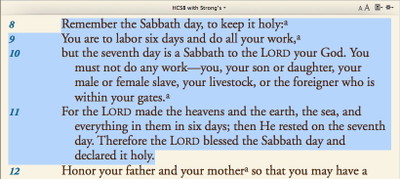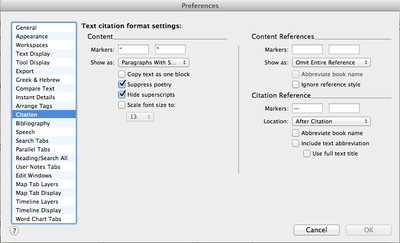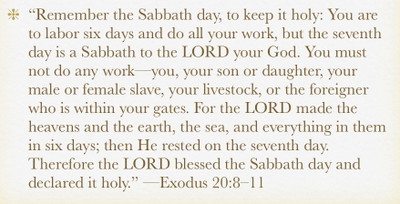In my previous post, I talked about the Keynote presentation I’m producing to teach a Sunday School class on “Understanding the Old Testament.” In that post, I surveyed the Accordance resources I am mining for the content of my Keynote slides. In this post, I want to explain the techniques I use to get Bible text out of Accordance and into Keynote.
Whenever I want to copy some Bible text to paste into Keynote, I do not use the standard Copy command in Accordance. Instead, I use the Copy As Citation command in the Accordance Edit menu. The keyboard shortcut for this command is control-command-C. Copy As Citation will copy whatever Bible text you select and format it however you like. You can have Accordance enclose the copied text in quotation marks, remove superscript characters, include or remove the verse references in the actual text of the citation, and even create a summary reference for the whole citation. For example, in discussing the Sabbath, I wanted to show how the two passages which list the 10 Commandments (Exodus 20 and Deuteronomy 5) give slightly different reasons for observing the Sabbath. Here’s my selection of one of these passages in Accordance:
If I do a standard Copy and paste this text into Keynote, I get this:
Note how this gives the text as I saw it in Accordance, complete with the tabs for the poetic formatting, the superscript footnote markers (which unfortunately have lost their superscript style—it’s on our to do list), and the individual verse references which only show the verse number rather than entire reference.
If I Copy As Citation, I get this instead:
Note how the entire passage is shown as a continuous paragraph without all the line breaks and indentations, how the footnote markers and individual verse references have been removed, and how quotation marks and a full, summary reference preceded by a long dash have been added at the end.
How Accordance formats the text when you Copy As Citation is determined by the Citation settings of the Accordance Preferences. Here are my current settings:
You can see that I have opening and closing quotation marks in the Marker fields for the Content, that I have chosen to suppress poetry and hide superscripts, that I am omitting all the verse references within the content, and that I have a long dash appearing before the Citation Reference. That’s why Copy As Citation formats the text as you saw in the previous screenshot.
Now, just as I use Copy As Citation rather than the standard Copy in Accordance, when I switch to Keynote I use the Paste and Match Style command rather than the standard Paste. One of the strengths of Keynote is all of its pre-formatted templates. Professional designers have carefully chosen fonts and styles which look right together, and I don’t want to mess up that design by pasting in a different font or style from Accordance. By choosing Paste and Match Style, Keynote will ignore the font and style information that got copied from Accordance and will instead match the style of the Keynote template. Here’s what I get when I use Paste and Match Style:
The font here is actually pretty close to the one I copied from Accordance, so the difference isn’t as obvious as it could be. It is easy to see however that the Keynote template uses a much larger font size than I copied from Accordance. By choosing Paste and Match Style, I can make sure the font, size, and style of text in all my slides remains consistent.
Those are the techniques I use to get properly formatted Bible text from Accordance into my Keynote slides. In my next post, I’ll show you a slick way to get images from Accordance into Keynote.






